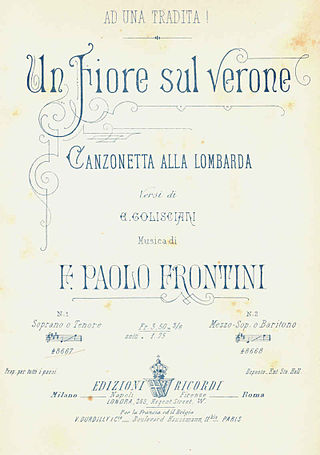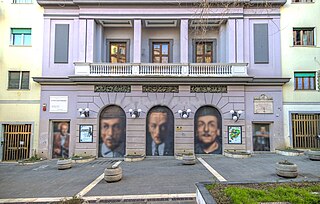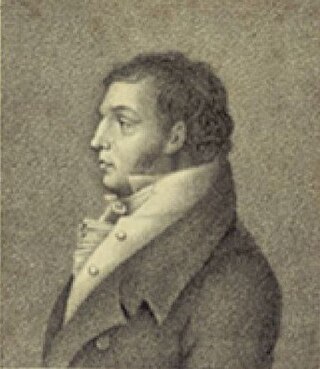
The Teatro Comunale di Bologna is an opera house in Bologna, Italy. Typically, it presents eight operas with six performances during its November to April season.

Treviso is a city and comune (municipality) in the Veneto region of northern Italy. It is the capital of the province of Treviso and the municipality had 84,669 inhabitants in September 2017. Some 3,000 live within the Venetian walls or in the historical and monumental center.

Macerata is a city and comune in central Italy, the county seat of the province of Macerata in the Marche region. It has a population of about 41,564.
Veneto is one of the 20 regions of Italy. The music of Veneto.

Antonietta Meneghel, better known by her stage name Toti Dal Monte, was a celebrated Italian operatic lyric soprano. She may be best remembered today for her performance as Cio-cio-san in Puccini's Madama Butterfly, having recorded this role complete in 1939 with Beniamino Gigli as Pinkerton.
Nicola Campogrande is an Italian composer and music journalist. He is the artistic director of the MITO SettembreMusica festival. He writes for the newspaper Corriere della Sera. His music is published exclusively by Breitkopf & Härtel.

Clorinda Corradi was an Italian opera singer and one of the most famous contraltos in history.

Enrico Golisciani was an Italian author, born in Naples. He is best known for his opera librettos, but also published a slim volume of verses for music, entitled Pagine d'Album ; many more of his poems intended to be set to music were published in the Gazzetta Musicale di Milano.

Arnoldo Foà was an Italian actor, voice actor, theatre director, singer and writer. He appeared in more than 130 films between 1938 and 2014.
Natale de Carolis is an Italian operatic baritone, who has had an active career in major opera houses internationally since the early 1980s. He is particularly associated with the works of Wolfgang Amadeus Mozart and Gioachino Rossini.

Giancarlo Monsalve Leyton is a Chilean spinto tenor. He is the Cultural Ambassador of his home town Valparaíso, a UNESCO World Heritage site. He is known for his portrayal as Don José in Carmen, Cavaradossi in Tosca, Turiddu in Cavalleria rusticana, the title role in Don Carlos, Riccardo in Un ballo in maschera, Prince Calaf in Turandot and Don Alvaro in La forza del destino

Teatro San Ferdinando is a theatre in Naples, Italy. It is named after King Ferdinand I of Naples. Located near Ponte Nuovo, it is to the southeast of the Teatro Totò in the western part of the neighborhood of Arenaccia. Built in the late eighteenth century, the seats are arranged in four box tiers, and the pit. It is most associated with Eduardo De Filippo and the productions of the 1950s under his direction. Closed in the 1980s and reopened in 2007, the San Fernando is managed by the Teatro Stabile of Naples.
Giampaolo Coral was an Italian composer.
Mario Mariani is an Italian pianist, composer, and performer.
Damiano Michieletto is an Italian stage director especially known for opera. He has staged productions at leading opera houses and festivals worldwide. His awards include the 2015 Laurence Olivier Award for the production of Mascagni's Cavalleria rusticana and Leoncavallo's Pagliacci at the Royal Opera House in London.
The following is a timeline of the history of the city of Treviso in the Veneto region of Italy.
The Teatro Contavalli was an opera house and theatre located at Via Mentana #2, in Bologna, region of Emilia-Romagna, Italy. Long since utilized as a theater, the site is now occupied by offices for the Centro Italiano di Documentazione sulla Cooperazione e L' Economia Sociale.

Eliodoro Bianchi was an Italian operatic tenor and later a prominent singing teacher. Born in Cividate al Piano and trained in Naples under Giacomo Tritto, he made his stage debut in 1793. Amongst the many roles, he created during the course of his 40-year career were Baldassare in Ciro in Babilonia and the King of Sweden in Eduardo e Cristina, both of which were composed by Rossini expressly for Bianchi's voice. He retired from the stage in 1835 and spent his later years in Palazzolo sull'Oglio, where he died at the age of 75.
Mario Cassi is an Italian baritone.

Teatro Coccia is the main opera house in Novara, and is also the most important "historical" theatres in Piedmont. It faces along via Fratelli Rosselli, and delimits piazza dei Martiri to the west and piazza Giacomo Puccini to the east.














